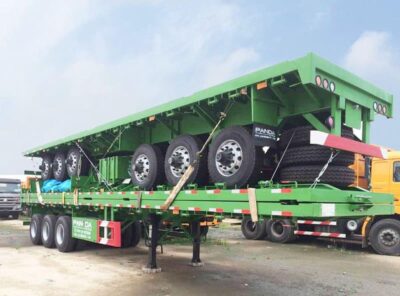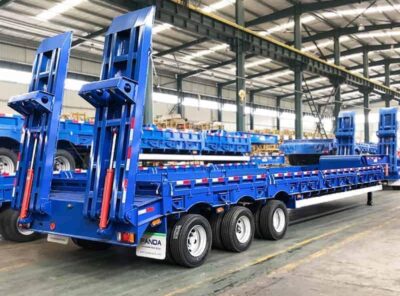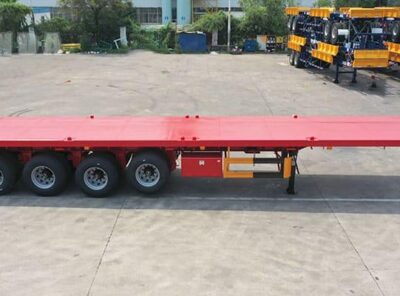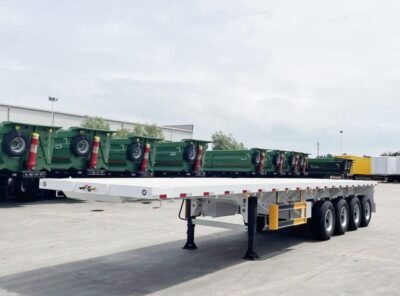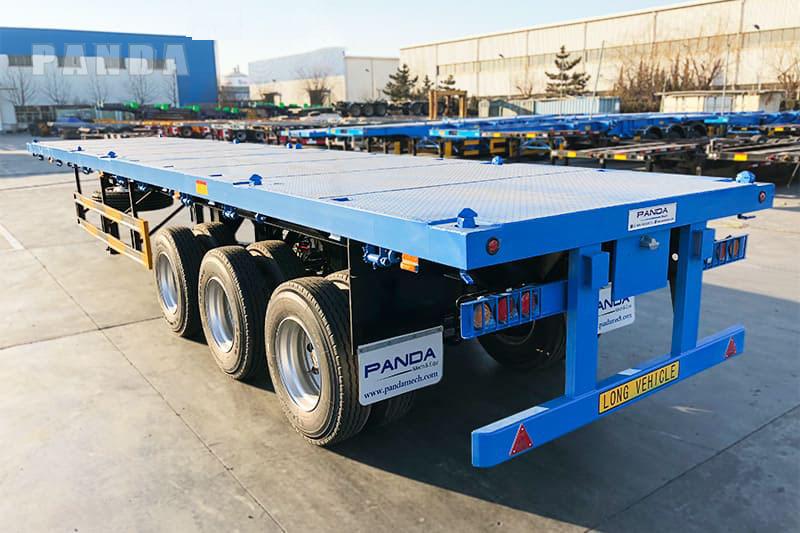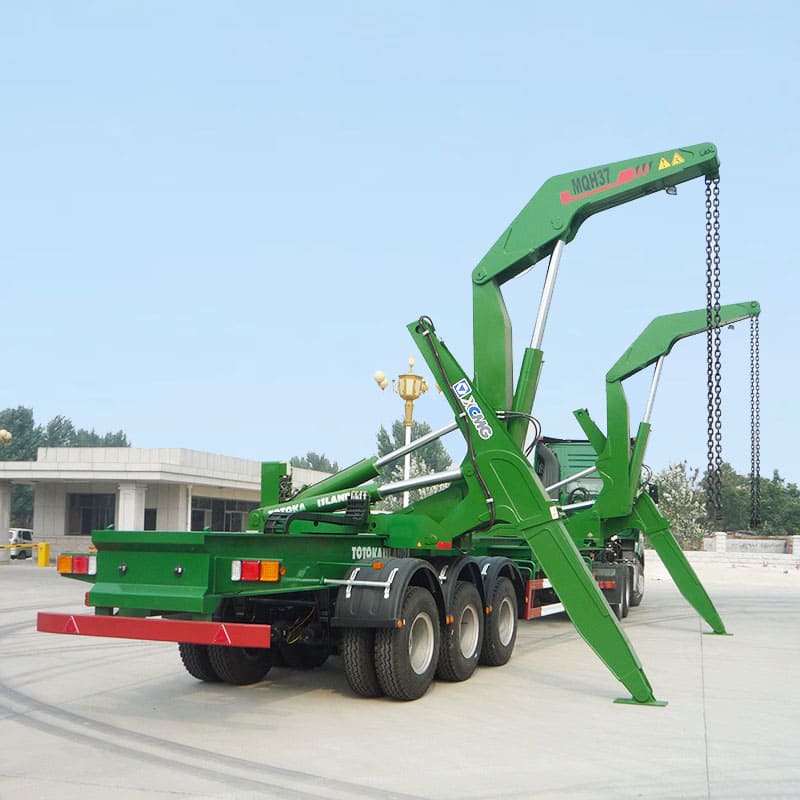Many people need to use containers for lots of transportation works, but how to lift the container? Today we will introduce for you.
How to lift a container?
The tipping structure of the vehicle allows the container to be lifted directly, which realizes the loading and unloading of containers without using the crane.
The container tipping trailer is controlled by hydraulic system, which can improve the operation efficiency. Usually, the price of container tipping trailers is higher, but the convenience it brings is also very impressive.
Its upper frame is with a roller, and it is perfectly fixed to the chassis below.

The roller rotates around the mounting point of the upper frame to work. There is also an extension arm that can be extended and retracted longitudinally. This extension arm is related to the weight of the container. Please note that the extension arm can extend outward and be unloaded.
The separation distance between the roller and the cable fixing point can be changed by pivoting. Thus, the distance between the cable fixing point and the roller relative to the container structure can be changed.
In this way, no matter we move the container or lift the container, we don’t need external force or power to change the distance of the cable.
This method is only suitable for the dumping process. When the lower frame of the container tipper is installed relative to the trailer body, the pivoting motion triggered on the upper frame around the hinge point axis will produce a loading or unloading position as needed.
Contact us for the specification and quotation of the container tipper trailer.
How to load containers onto a trailer
If there is no crane in the workshop, generally there are 2 ways to transport the container to the trailer.
1. Using container side loader
Containers can be loaded onto the trailer by the container side loader.
Side lifter, commonly is referred to the crane module powered by a hydraulic system. This hydraulic system can help the container to be lifted from the ground or be transported from one vehicle to another. The lifter is generally located on the top of the chassis, and can move along the chassis to cope with containers of different sizes.

Power supply : generally speaking, the power of side lifter is provided by the engine fuel, but the PTO of the trailer powers these, so the situation is relatively different.
In place, you can also use hydraulic systems to control the landing gear to help lift up fully loaded containers. This will ensure that the vehicle is as stable as possible. We can adjust these landing gear to achieve the operation we want, especially when working in some places with uneven ground, which can improve safety performance and provide greater lifting weight. And on the trailer deck, you can also adjust the landing gears to achieve the extension and tilt functions.
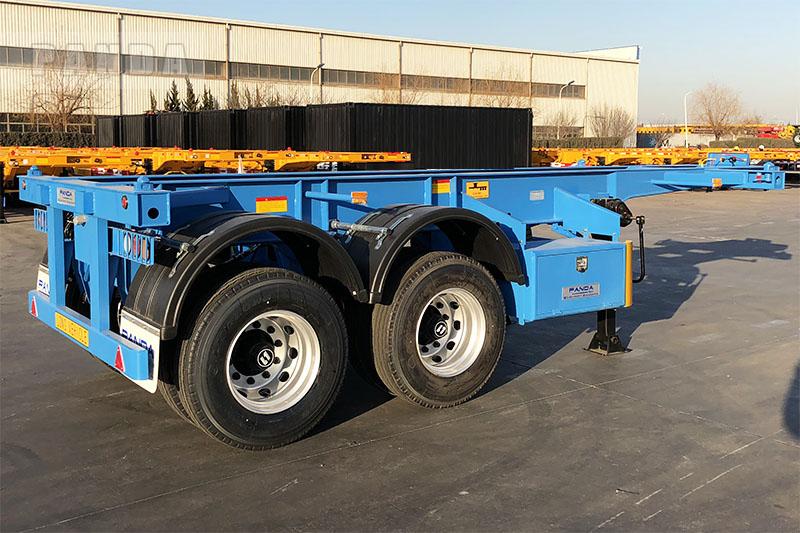
2 axle container chassis
Chains: There are various chains from the upper part of the side lifter to the corner castings at the bottom of the container. The general trailer has a special link function and is located between two containers of 20 feet, which can facilitate the two containers of this size are locked together. In this case, it is as if a 40-foot container has to be handled in total.
Chassis: The chassis is important because it can determine the loading capacity, and at the same time it also provides support for the crane when it is working, ensuring that the crane works normally.
Remote control function: Through the remote control function, the controlling rod and keys are used to control the device, and the device is used to transport the container to the trailer and put it at a suitable location.
2. Using container forklift
We often use forklifts to transport containers. The forklift can easily lift the container and place it on the trailer.
When we use the forklift, we must operate correctly to reduce the damage to the trailer.
In order to ensure using forklift correctly, we must ensure that the operator
1). After being trained on the basic working principle of the forklift to transport containers.
2). Know how to operate a special forklift
3). Understand the safety measures needed when using the forklift
4). Make sure that the forklift is lifted and maintained in time, and make sure that all parts can work normally.
Forklift safety:
The lifting fork has an extension of the backrest on the fork, which helps prevent containers from falling to the side where the driver is seated. This part is very important, because at the beginning of acceleration, or when it suddenly stops and the situation on the bumpy ground, most of the container will move in the direction of the driver.
he lifting fork is also equipped with an overhead protection device to prevent your container from accidentally falling onto the driver when the carrier lifts or lowers the container.
Steps
- Inspecting the Area: Before loading the shipping container, visualize the process and make sure the area surrounding the container, along with the path to the trailer, is cleared of any obstructions. The flatbed trailer should be set up such that it’s facing the broad side of the container.
- Securing the Container: Ensure that the container is well-secured using cables or chains prior to lifting. This helps keep it balanced and prevents accidental insulation damage.
- Using a Crane or Forklift: Ideally, a forklift should be used for moving relatively lighter loads while a heavier, 20 or 40-feet container requires a heavy-duty crane capable of weight upwards of several tonnes.
- Lifting the Container: Start the crane or forklift and slowly engage it to lift the container. Depending upon your facilities, cranes may lift directly, or special top frame lifting devices connected to 4 lifting points globally known as ISO points may be used to load the lower-end of the shipping container into the bottom end points of your trailer (The most bottom set of ISO corner casting points at both front and end of the trailer).
- Guide the Container: As the container is being lifted, use guides or spotter personnel on the ground to help position the container accurately above the flatbed trailer. Communication ensures the safe maneuvering of the container onto the trailer.
- Lowering the Container onto the Trailer: With the container suspended the appropriate height above the trailer, smoothly and gradually lower the unit onto its platform, closely monitoring that it’s laying flat and fitting nicely onto its exterior frame.
- Securing the Container on the Trailer: Secure the container firmly to the trailer’s bed. Use corner chassis twist locks or chains with hook systems. Chalk or rubber blocks could act as shock absorbers and provide stability for journey transportation; some also opt for tie-down straps coupled with ratchet straps to ensure that the container doesn’t shift during transport.
- Final Inspection: Once the container is lowered and secured onto the trailer, conduct a thorough inspection to ensure the container is indeed secure and ready for transportation.
How to move a container by hand?
If we want to move the container by hand, it is fundamentally impossible. We can control the container crane to move the container and move the container to the location we want to move.
Features of container cranes:
- Lift heavy containers;
- Handle all container types;
- High-cost performance;
- Work in a narrow space;
- Portable, on-site, and between different sites;
Disadvantages of container cranes:
Unable to stack containers

